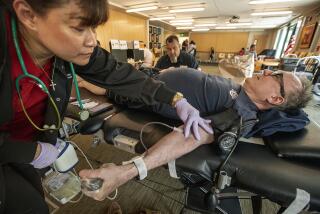Red Cross Agrees to Tighten Its Blood Safety Measures : Health: FDA assures that nation’s supply is safe, but it presses for more safeguards against contamination by AIDS virus and other diseases.
- Share via
WASHINGTON — Under orders from the Food and Drug Administration, the American Red Cross has agreed to take further steps to ensure that the nation’s blood supply is safe from contamination by the AIDS virus and other blood-borne diseases, the FDA announced Friday.
The agreement stems from a lawsuit filed against the American Red Cross--the nation’s largest blood supplier--by the Justice Department on behalf of the FDA. While acknowledging vast improvements in the ability of the Red Cross to protect the blood supply, the suit charged that some deficiencies remain in the blood collection system.
Officials at the FDA, the Justice Department and the Red Cross hastened to add, however, that the blood supply remains safe and free from contamination.
“For any patient requiring a blood transfusion, the risk of not receiving that transfusion outweighs the risk of receiving blood,” FDA Commissioner David A. Kessler said in a statement. “We are committed to maintaining the safety of the blood supply.”
The FDA declined to be specific about the nature of the deficiencies--other than to say that they involve ongoing record-keeping and accident-reporting problems. But by filing the suit--and obtaining a consent decree from the Red Cross--the government places the matter in the hands of the courts, which will have the power to levy fines or other penalties if the deficiencies are not corrected.
The American Red Cross--which two years ago launched a multi-year, $140-million reorganization to strengthen its procedures--said Friday the agreement reached with the FDA “establishes priorities and timetables” consistent with its ongoing efforts.
“We will not only fulfill the requirements of the FDA, we will surpass them,” said Elizabeth Hanford Dole, president of the American Red Cross. “This agreement will help strengthen the safety . . . and guarantees already built into the system.”
The American Red Cross collects 6 million units of blood, half of the nation’s supply, annually. Its procedures have been under scrutiny by Congress and federal health officials for more than five years.
Both the FDA and Rep. John D. Dingell (D-Mich.), chairman of the House Energy and Commerce Committee, have cited numerous problems within the organization, including deficiencies in its computer record-keeping systems and in its procedures for handling error and accident reports.
In 1988, the Red Cross agreed to correct violations of blood safety laws and in 1990 announced a series of major internal changes.
Nevertheless, the FDA said without elaborating that its investigators have continued to find violations of blood safety laws and regulations at various Red Cross facilities and have notified national Red Cross officials. In some instances, the agency has begun proceedings to revoke licenses of local agencies.
The FDA said Friday that the blood organization has agreed to establish stronger controls to assure the quality of the blood supply and to improve its computer systems, its records management and the way it investigates and reports errors, accidents and adverse reactions to transfused blood.
The agreement also requires the Red Cross to conduct annual performance audits of each of its 47 regions.
The decree provides for a series of timetables by which the Red Cross must make the improvements, all of which are enforceable by the courts, the FDA said.
The biggest longstanding concern has been the possibility that transfusion recipients could receive blood contaminated with the human immunodeficiency virus that causes AIDS. Blood also can carry other disease-causing organisms, such as the viruses that cause hepatitis, a serious liver ailment.
But the FDA said that, while breakdowns have occurred in some parts of the blood-collection system, multiple protections exist to “minimize the potential that contaminated blood will reach the public.”
Times staff writer Ronald J. Ostrow contributed to this story.
More to Read
Sign up for Essential California
The most important California stories and recommendations in your inbox every morning.
You may occasionally receive promotional content from the Los Angeles Times.













